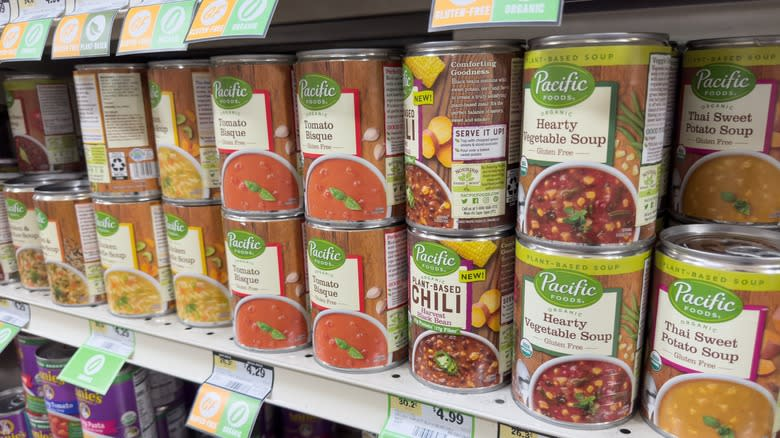Casseroles are the cozy champions of weeknight dinners—warm, satisfying, and easy to throw together. But at the heart of many classic casserole recipes lies one highly debated ingredient: canned soup. For some, it’s a lifesaver. For others, a culinary crime. So, what’s the truth? Is canned soup really that bad? Or does it deserve a spot in your pantry?
Let’s explore the real story—unfiltered and unbiased.
The Appeal of Canned Soup: Convenience You Can’t Deny

Let’s face it—life gets busy. Between work, errands, and trying to keep your sanity, sometimes cooking from scratch just isn’t realistic. That’s where canned soup shines. It delivers moisture, richness, and flavor without needing to chop, sauté, or simmer.
Need dinner in 30 minutes? Canned soup can get you there. Whether it’s cream of mushroom for your green bean casserole or cream of chicken for your cheesy rice bake, it’s a shortcut that many home cooks swear by—and for good reason.
What’s in the Can? A Nutritional Breakdown
Now for the flip side. Not all canned soups are created equal, and the nutrition label tells the real story. Many popular varieties are packed with sodium, preservatives, and artificial flavors. That’s a big concern if you’re watching your heart health, sodium intake, or aiming for clean eating.
But here’s the thing: you have choices. More and more brands are offering low-sodium, organic, and preservative-free options. If you love the convenience but want to keep it healthy, don’t skip the label. Read it like you mean it.
Video : Are Canned Soups Healthy or Harmful (The Truth Revealed by Science)
Flavor Wars: Homemade vs. Canned
Taste is subjective—but when it comes to flavor depth, homemade bases almost always win. A base made from real butter, garlic, flour, stock, and cream delivers richness and nuance you just don’t get from a can.
That said, not everyone is looking for gourmet complexity. Sometimes, comfort food is supposed to taste like what Mom used to make—with canned soup and all. If you grew up on tuna noodle casserole, that familiar flavor might be just what you crave. And in that case? Mission accomplished.
Why Canned Soup Stuck Around: A Nod to Tradition
Canned soup wasn’t just a post-war invention—it became a kitchen staple that fueled an entire generation’s cooking style. From potlucks to holiday dinners, canned soup earned its place in iconic dishes. Think green bean casserole at Thanksgiving or that creamy chicken-and-rice bake you grew up with.
For many, removing canned soup from these recipes feels like rewriting family history. And let’s be honest—nostalgia tastes really good sometimes.
The Additive Argument: Are Preservatives a Problem?
Preservatives often get a bad rap. While they can sound scary, most are deemed safe in the quantities used in food products. Still, if you’re sensitive to certain additives or just prefer to keep things natural, this is something to pay attention to.
Want to dodge preservatives entirely? Make your own base. You’ll get full control over every ingredient, from the dairy to the seasoning.

Time Is Money: Which Option Saves More?
Canned soup is cheap—especially when you factor in the time you save. A single can might cost $1.50 and eliminate 20–30 minutes of prep. But homemade bases can actually be affordable too, especially if you’re cooking in bulk or using pantry staples like flour, milk, and broth.
If cost is your biggest concern, both options can work—just depending on what ingredients you already have on hand and how much time you’re willing to invest.
Sustainability Check: What About the Environment?
Cans = waste. Even if they’re recyclable, manufacturing and recycling them still consume resources. Homemade sauces cut down on packaging waste and typically use fewer processed ingredients, which is a win for the planet.
That said, if you do opt for canned soup, choose brands that support sustainable practices—and always recycle when possible.
What the Experts Say: Mixed Reviews with a Common Theme
Chefs tend to prefer homemade everything. But even they acknowledge that canned soup has its place—especially for home cooks who just want a quick, hearty meal. Nutritionists, on the other hand, urge consumers to choose wisely. Look for soups with simple ingredients, minimal sodium, and no artificial additives.
The takeaway? Be informed. Know what you’re putting into your body. And don’t beat yourself up for choosing convenience when you need it.
Video : The effect of food on the intestines
So… Is Canned Soup the Villain or the Hero of Your Casserole?
Honestly? It depends.
If you’re looking for a fast, affordable, no-fuss solution for a weeknight dinner—canned soup delivers. If you’re cooking for health reasons, flavor depth, or to impress at a dinner party—homemade might be your best bet.
The good news? You don’t have to choose one forever. Use canned soup when life gets busy. Go homemade when you’ve got time to spare. There’s room for both in a well-balanced kitchen.
Final Thought: It’s Not Cheating—It’s Cooking with a Plan
Using canned soup isn’t “bad.” It’s practical. It’s nostalgic. And sometimes, it’s the smartest move you can make after a long day. Just be aware of what’s in your can, balance it out with fresh ingredients when you can, and make the choice that works for you.
At the end of the day, good food is food that feeds you—body and soul. Whether it comes from scratch or a shelf.


